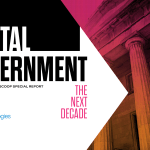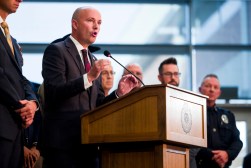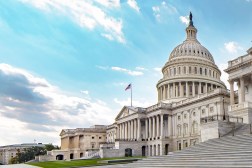Government’s technology officials step out from ‘behind the curtain’

Technology is baked into the daily processes of virtually every local government agency today, and government services that still relied on paper or in-person interactions at the beginning of 2020 have seen rapid digital transformations this year as a result of the coronavirus pandemic.
With technology adapting to meet the needs of a mostly remote government, public sector technology executives are no longer “behind the curtain” of government operations, Dallas Chief Information Officer Bill Zielinski told StateScoop, but rather they’re helping policymakers make business and regulatory decisions about the once-disparate issues of data, security and technology. This model of a more interconnected government, Zielinski and other C-suite technology officials said, is how all local governments could operate in the near future.
Zielinski, who began his term with Dallas in April after 11 years as a CIO in the federal government, said that one of the easiest ways to think about how government might look in the future is to look at the questions technologists were asking when he began his career in the public sector a decade ago. For example, it’s no longer enough to just “command the technology,” he said, especially as more people who understand technology join the ranks of local government — thanks in part to organizations like Code for America and 18F. As a CIO, Zielinski said he’s expected to have as many business conversations about how to deliver technical capabilities or a new digital service than about the actual capability of the technology itself.
“[We have to ask] how technical capabilities can be delivered. We now have to know and understand, from all those options that we have, what’s the cost impact and what’s the impact of the risk? How does it impact our agility as a business?” Zielinski said. “How much do you want to own? Do you want to own any of it? Do you want to rent it? Do you want to get a managed service? Do you want to operate it?”
Austin Chief Information Security Officer Shirley Erp told StateScoop she’s increasingly responsible for anticipating legal requirements and regulations that affect government technology and explaining them to the departments that she serves. On top of monitoring the risk that advances in technology pose to city government, like wearable devices, AI-powered systems and “internet of things” solutions, Erp said she has to consider the city’s business needs, funding constraints and resource limitations before procuring anything. Because cities are only growing more reliant on technology, especially to maintain operations during the coronavirus pandemic, the role of technologists in government will only expand.
“We’re no longer just the technologists behind the curtain that are creating the magic,” Zielinski said. “We’re actually out in front relative to the utilization of the technology, the protection of the technology and the understanding of the technology in the different ways it can be deployed.”
Tailor-made
But just because technology is embedded in government processes doesn’t mean that it needs to be run by a CIO or CISO. Physical security procedures in government buildings rely on technology like ID readers, cameras and biometric scanners as much as they rely on human agents. But a CISO isn’t going to take over a building just because it contains technology. Over the next few years, technologists need to become partners with other parts of their organizations, he said, and ensure they have a seat at the table when decisions are being made about about security or procurement.
And right now, said Carrie Bishop, San Francisco’s chief digital services officer, government technology vendors are often “woeful” when asked to produce systems that fit the specific needs of cities. It can be hard, she said, to find vendors that are incentivized to update their legacy systems to meet modern user expectations, like allowing an employee to use one login for multiple systems.
San Francisco Chief Data Officer Jason Lally said the city is also looking into opening up its procurement process to include a wider audience of vendors including those that don’t normally work with the public sector.
“Government is particular and specific in certain ways, but there are a lot of things we do that are actually just as generic and commodity as what is done in the private sector,” Lally said.
While Bishop and Lally said their city has work to do in the coming years to “reorient” government services to be more user-friendly, the near future will also require the private sector to improve its ability to provide government with tools that solve specific problems, rather than one-size-fits-all solutions.
“Just because of how resource-constrained we will be, we’re not going to be able to accept that, ‘Oh, we can use this really cruddy to do this thing that it wasn’t designed for that’s been around for 10, 15, 30 years.’ We’re going to have to say, ‘We need something more modern here, we need something that will enable us, as opposed to being tacked on,’” Lally said.
Data-driven
Data, Lally said, will also play a larger role in government’s future. Like many big cities, San Francisco operates a robust open-data portal. But because much of the city’s data collection isn’t attached to specific city goals or initiatives, the data sets are gathering dust, he said, when they could be helping residents or government employees improve the city.
A “mindset shift,” Lally said, toward collecting data that solves problems, rather than just to have it on hand, is in the works in his office — and collecting data to reduce the spread of the coronavirus has accelerated that mission.
“From a data and analytics perspective, where I see us going … is I want us to be more focused on problem-solving. So rather than thinking of data domains and abstractions around data, really getting very specific and asking what the problem we’re solving is and who we’re solving it for,” he said. “Rather than start from what are the core data sets, we’ll start from what are the problems.”
Hank Garie, Philadelphia’s chief data officer and geographic information officer, said the city’s ability to collect data that’s relevant to specific community and demographic problems is possible when the city’s organizational structure allows him to have a say on policy decisions that previously might have occurred without being informed by data. Geographic information systems, which produce location data that is increasingly used by government to deliver customized experiences to residents, is on the rise, he said.
“It’s telling me, and it’s telling the rest of the city, that location really matters. Issues and events that occur throughout the city all happen in places,” Garie said. “All that comes to pass when your GIS is at a place in the organization where it can contribute and make a difference.”
This story is part of Digital Government: The Next Decade: A StateScoop & EdScoop Special Report.

This story was featured in StateScoop Special Report: Digital Government: The Next Decade (2020)






